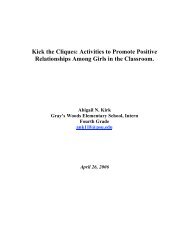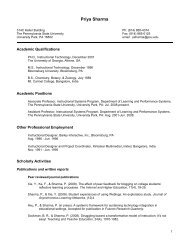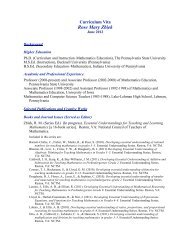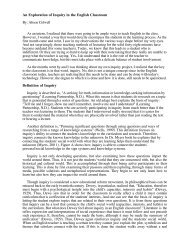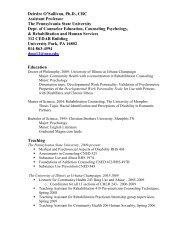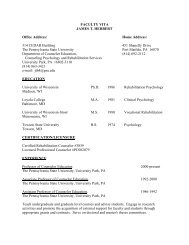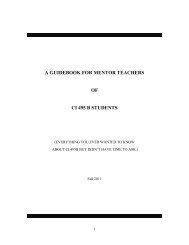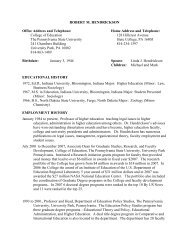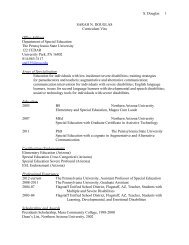Lets Focus! - the Penn State College of Education
Lets Focus! - the Penn State College of Education
Lets Focus! - the Penn State College of Education
Create successful ePaper yourself
Turn your PDF publications into a flip-book with our unique Google optimized e-Paper software.
a great impact on <strong>the</strong> academic and social life <strong>of</strong> a child. Their poor organizational skills<br />
would pervade through <strong>the</strong>ir ma<strong>the</strong>matics, writing, handwriting and reading skills.<br />
Fur<strong>the</strong>rmore, <strong>the</strong> student who has difficulty returning to a task or a poor sense <strong>of</strong> time, <strong>the</strong><br />
student may not complete work on time, or even at all.<br />
O<strong>the</strong>r symptoms <strong>of</strong> executive dysfunction have an impact on a child's social or<br />
behavioral skills. Some <strong>of</strong> <strong>the</strong>se symptoms include having a poor internalization and<br />
generalization <strong>of</strong> rules, poor social clues, trouble transitioning, poor frustration tolerance<br />
and becoming angry frequently and quickly (http://www.pediatric neurology<br />
\.com/newpage 11.htm). These are <strong>the</strong> symptoms <strong>of</strong> executive dysfunction that cause for<br />
seventy-two percent <strong>of</strong> children with ADD/ADHD to argue with adults, sixty-six percent<br />
blame o<strong>the</strong>rs for <strong>the</strong>ir mistakes, seventy-one percent act touchy or are easily annoyed,<br />
forty percent swear, forty-nine percent lie, and fifty percent steal (http://www.<br />
pediatricneurology.com/newpage 11.htm).<br />
In addition to showing symptoms <strong>of</strong> executive dysfunction, many children with<br />
ADD/ADHD exhibit co-morbid disorders. These disorders accompany <strong>the</strong> diagnosis <strong>of</strong><br />
ADD/ADHD or <strong>the</strong>y are <strong>of</strong>ten misdiagnosed as ADD/ADHD. "John Ratey refers to<br />
<strong>the</strong>se as "shadow syndromes" (http://www.pediatricneurology.com/newpage 11.htm).<br />
What are <strong>the</strong> co-morbid disorders that <strong>of</strong>ten accompany ADD/ADHD?<br />
A co-morbid disorder that accompanies twenty to thirty percent <strong>of</strong> children who<br />
are diagnosed with ADD/ADHD, is a learning disability. Many <strong>of</strong> <strong>the</strong> characteristics <strong>of</strong> a<br />
learning disability are <strong>the</strong> same characteristics <strong>of</strong> ADD/ADHD. Difficulty following<br />
directions, sequencing or organizing problems and dysgraphia are all associated with<br />
learning disabilities and ADD/ADHD. According to Larry Silver, a child is tested for a<br />
7




